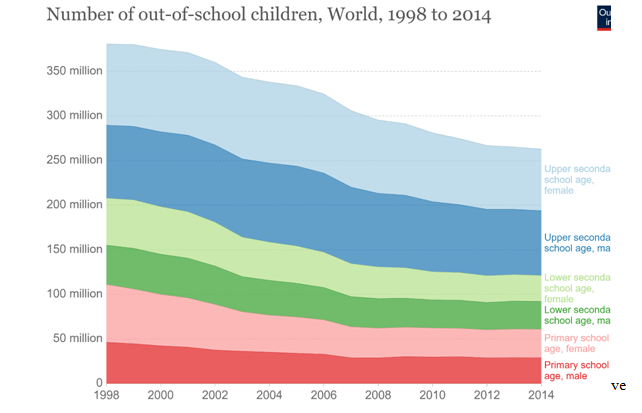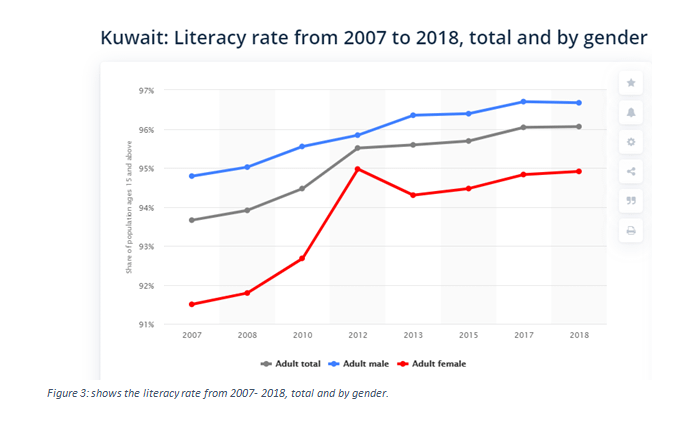Title: Sustainable Development Goals # 04: Quality Education
Category: Coursework
Sub Category: Research Essay
Subject: Corporate Social Responsibility
References: APA
Introduction:
The changing pace of the word requires a sustainable system framework in which the countries can develop and progress according to the social welfare and prosperity of the country. For this purpose, the United Nations has established a set of rules that are to be adopted by the listed 193 countries. The United Nation’s Sustainable Development Goals (SDGs) also known as the Global Goals, are a series of potential objectives designed within the boundaries of universal agreement to eradicate economic, environmental, individual, and many other issues like ending poverty, protection of the species that make the earth habitable and, ensure that peace and prosperity be enjoyed by all people in the present as well as foreseeable future. Over the overwhelming scientific and empirical evidence that the world requires a more radically sustainable approach (Squires, 2017). These goals were formally adopted by the members of the states near 2015. The SDGs were strategically designed from 2016 to 2030. The objectives of the SDGs outline are constructed in such a way that it is sufficiently robust proven scientifically, accepted keeping in view the policies and restrictions of political nature and publicly intuitive.
One of the important sustainable development goals is education. Education has a direct contribution to increasing the national income through the enhancement of knowledge, skills, and labor force productivity and indirect contribution through improved opportunities of employment, rate of growth of the population, the reduced poverty rate along with equal distribution of wealth and assets. To gain the benefits of education effectively, the outputs expected from the education must be in alignment with the needs of society. Kuwait is one of the politically democratic countries of Gulf States which uses its educational system to encourage Islamic obedience and non-critical nationalism. For Kuwait, good educational opportunities are responsible for bringing a radical positive change in the rising generation of the country and to raise the standards of living for the individuals and families residing in Kuwait (Cutter, 2016).

RESEARCH PROBLEM:
The government of Kuwait is very strict concerning the provision of education. Like most of the countries, Kuwait has taken a leading role in providing educational services. In the last 40 years, the government has spent a significant amount of resources on the provision of educational facilities. Due to the educational externalities that arise from the spread of education, some educational institutions provide education free of charge. Educational expectations helped reduced the illiteracy rate in Kuwait but comparison with the international educational standards shows another picture of the education standards residing in Kuwait (Allen, 2016). Since the educational standards in Kuwait revolve around the traditional or Islamic values, the expression of freedom of speech among the students is very low. Public schools in Kuwait provide very fewer opportunities regarding freedom of speech against the education council.
While Kuwait clams to be a knowledge-based economy, it has a reverse education system concerning the economy. The economy runs the education system. This reductive approach is said to shift Kuwait’s education system out of the public sector. Due to this restrained approach, students of Kuwait still lack the knowledge and training required for the international markets. The neoliberal trend of greater standardized training and training driven by the market did not serve Kuwait’s educational markets well (Mohammed, 2002). The major concern, in this case, is the effect of nationalism and religion on Kuwait’s traditional and authoritarian approach to the standards of teaching and learning. The sections of Kuwait’s policies regarding primary and secondary education are defined and how the government is devising strategies that could potentially improve the education standards, are observed. The status of higher education in Kuwait and its competitiveness in the national and international markets. The themes and research problems are based on the criticality and creativity of Kuwait’s educational policies and their effects on the overall economy (Burney, 2009).
RESEARCH QUESTIONS:
According to the aspects of the research problem, some questions are designed which shows Kuwait’s educational status following the policies of sustainable development goals and what are the requirements set by the UN concerning the improvement is SDGs to be followed by Kuwait (Al-Nakib, 2015).
Q1: What is the status of SDGs’ implications in the world and specifically Kuwait? What are the statistics of literacy rates segregated according to gender and population?
Q2: What is the educational implication concerning educational facilities and provisions followed by Kuwait?
Q3: What are the Quality reforms and Quality education in the light of SDGs implemented by Kuwait?
Q4: What are the statistics about the number of teachers employed in various educational institutions in the primary and secondary education sector of Kuwait? What is the role of tertiary education in Kuwait?
Q5: What are the higher education governance and future outlook of education’s quality in context with the UN’s SDGs?

SDG & World:
The SDG (Standard Development Goal) is an initiative of the United Nations and 193 countries aimed at improving the standard of living of people living around the world. Quality education is one of the points among them, and more attention is paid to improving the quality of education and education. Richie (2019) provides data on children out of school in 2019; between 1998 and 2014, 263 million children did not go to school. John & Tsang, (2020) elaborates “Sustainable development goal number 4 is concerned with the education’s quality globally which the countries are improving with time”. Matters like lifelong learning and teaching opportunities, knowledge for everyone, and easy access to all kinds of education is a significant need for every country. At the inception, poverty and armed terrorism hampered the quality of education which resulted in a deprivation of learning for the vast number of children. This critical cause had prevented children from attending schools and universities. The less fortunate children faced this problem twice as more as middle and upper-classed individuals.

been major changes in trends, and in this regard, much work has been done to improve education in all sectors as well as to further improve the quality of education. Global coverage has reached 91% worldwide and continues to grow at a sustainable rate. To gain success in life women must be provided with equal education opportunities as men. In four developing countries, women are prohibited from attending school and primary education. It also explains data showing that roughly half of the schools in developing countries are in conflict zones with significant backwardness in enrollment. The total number of unskilled youth reached 103 million of which 60% were women. Six out of ten children did not develop basic reading and math skills. Despite the increase in student enrollment worldwide, about 57 million students still did not complete primary education.
KUWAIT & SDG:
The SDG Knowledge Platform (2006) published an official statement from the State of Kuwait on the SDGs and their part in refining the quality of learning in Kuwait: Kuwait is an emerging state and has advanced an idea of quality development. Almost 15% of the total budget goes to education. The Government of Kuwait has published an overview and set an agenda to achieve vision 2035 “The State of Kuwait is fully committed to providing everyone with the opportunity to achieve the highest possible level of education. This is enshrined in Kuwait Vision 2035, which has been incorporated into Article 13 of the Kuwaiti Constitution and is based on Kuwait’s firm conviction of the fundamental importance of education as a basis for the development of human rights. The state provides free education to everyone from kindergarten to college and provides the educational admittance in elementary school and college to everyone. Education is an important component of Kuwait’s annual national budget. For example, in 2014 it represented up to 16.2% of total public spending. “ The University of Kuwait prioritizes knowledge innovation, and this can be demonstrated by the establishment of the Office of the Vice President for Research. (OVPR) to lead the industry in research and promote scientific research. It is a key pillar of Kuwait University’s vision of research excellence and the commitment of all faculties to a creative, experimental, investigative, experimental, collaborative inquiry and scientific complexities with contemporary challenges, and a system of rules and subsidies. A recent national report indicates that in 2015 the literacy rate was less than 2%. The maximum enrollment of children in kindergartens, primary and secondary schools was 80%, 97%, 94%, and 82%, respectively.
The same report indicates that several projects implemented under the Creative Human Capita component.

Kuwait’s Literacy Rate:
Plecher (2020) published a statistical report on the literacy rate in Kuwait from 2007 to 2018. The report indicates that the overall average adult literacy rate of men is 93.66% 94.79% and women, 91.5%. In 2008 the overall adult literacy rate reached 93.91%, the statistics again rose in 2018.

Quality of Education in Kuwait:
Since independence, Kuwait has made education a cornerstone of its central policy. In 1960, Kuwait had the largest budget for education in the Arab world. This priority was affirmed and legitimized during the writing of the Constitution of Kuwait (1962). An article of the constitution guarantees that ” Education is a prerequisite for the advancement of society provided and supported by the state.” Supplemented by the article of the constitution, the importance of education was greatly emphasized. It was described as “a right guaranteed to all Kuwaitis.”
The prioritization of education by the state led to a series of educational developments at that time. In the early 1960s, the Ministry of Education appointed several experts who were solely responsible for establishing the university. The establishment of higher education institutions in Kuwait reinforced the Government’s efforts in 1966 which was five years after independence. Government-funded grants that date back to 1939 when Kuwaiti students were appointed to Al-Azhar University in Egypt; Cairo. These government-sponsored campaigns for higher education paved the way for the comprehensive welfare system that Kuwait is proud of today. However, although the country spends about 15% (2015) of its total spending on education (Kuwait Times, 2017), Kuwait is ranked 85th in the world in higher education and 88th in education quality (2016), According to the Global Competitiveness Report. Even the slogan of Kuwaiti higher education – in 2015, Kuwait University – ranked 9 (in the Gulf Cooperation Council region), 19 (in the Arab world), 83 (in the Middle East and Africa region (North).
Educational Reforms in Kuwait:
Group, (2017) states “Kuwait’s education sector, is ambitious due to the need to adapt to high enrollment rates and government efforts to address long-standing problems in public education, is undergoing major reform in 2017. Key challenges include the shortage of qualified teachers, relatively low enrollment rates in higher education, and quality education standards”. Numerous government based improvements and funds are being implemented, with those started in the public education sector under the Kuwait integrated education reform program and the school education quality improvement project, the goal is to improve the country’s education.
[ Get Best Coursework Writing Help From Expert Coursework Writer ]
Teachers:
Due to the small number of local teachers, most teachers in public and private schools are employed from abroad, usually on a two to three-year contract. There are thirty thousand nine hundred and fifteen non-Kuwaiti people who worked in the Ministry of Education, including seventeen thousand one hundred and ten women and thirteen thousand eight hundred and five men. This is the highest among all ministries, followed by the Ministry of Health. To fulfill its commitment to hire young Kuwaitis, the government is progressively trying to replace foreign academic workforce with domestic labor, announcing its purpose to terminate teacher contracts in early 2017, dismissed foreigners. Introduce and encourage ministry officials.
Tertiary Education:
In total, there are fifteen advanced learning institutions are operating in Kuwait: three of them are municipal and the rest of them are private. The only municipal university in the country: The University of Kuwait, which was established in 1966 and offers courses in science, education, social sciences, and humanities. In 2016/2017, the institution had more than thirty-seven thousand students; The huge majority of Kuwaiti citizens who received seven thousand full government scholarships. Since 2008. To relieve this pressure and to cope with an increase in registration in higher education, Kuwaiti authorities have taken an absolute decision in 2004 to build a new municipal university.
Future Outlook:
The government of Kuwait has set a vision to improve the quality of education. In other words. The State of Kuwait will achieve the following goals in the education sector. By 2030, make sure that all the male and female students have free access to first-class education either primary or secondary level. It is to ensure that all the early age children got free access to a high quality of education and care, because of which they are ready for the next level of learning. Make sure that all the men and women get equal chances to attain first-class and inexpensive practical and occupational education. There must be a noteworthy rise in the number of youth with applicable services for employment, decent work, and entrepreneurship. It is of utmost desire to eradicate gender discrimination and to make it sure the equal access to all levels of learning, it also includes the personals with physical disabilities. Make sure that all the students have learned the information and skills which are the necessity to promote sustainable growth, it must not be limited to the learning only but must be spread away to the development, lifestyle, and gender equality in social privileges, which promotes a peaceful and non-violent culture. Building and improving educational institutions that take into account the needs of children, disabilities, and gender and provide safe, non-violent, inclusive, and effective educational environments for all. It must be assured that by 2020, there should be an increase in the number of scholarships for the developing countries and small islands so that the students from those lands can also attain higher education with privileges.
Conclusion:
Standard Development Goals is a set of visions that have been defined by the world leaders of 193 countries and they have decided to set forth visionary goals for the future and they have decided to overcome the basic problematic issues in almost every walk of life. One of the most important parts of SDG is “Quality Education” that is to enhance the quality of the education of the world and for the purpose, the leaders of the world have decided to set some goals and a vision for the future to meet it, vision in terms of the student enrolment, increase in the proportion of females enrolment in the educational institutes either primary, secondary or higher levels. Kuwait is a developing state and its government since its independence has emphasized a lot over the improvement of the quality of the education. For the purpose, the government has set 15% of its whole budget for education, and the ministry of higher education has worked a lot in the following terms, like lesser hiring of the foreign staff, increase the employment of Kuwaiti citizen, and to advance the educational institutes with technology, and other important elements required for the good education. Whereas the government is also keen to establish new public institutes in the country which are relatively lesser in number than the private institutes (higher education) as well as to establish the research institutes in order to promote scientific research in the country. For 2030 the government of Kuwait has set a vision that they will achieve up mentioned goals and they will enhance the education in the country while regulating the Kuwaiti nationals as well as working hard to promote the idea of getting a higher education and for that government is providing a great number of scholarships too.
[ Are you struggling to write your coursework Obtain professional Help from our expert coursework writer ]
References:
Affairs, D. o. (2020). United Nations. Retrieved from UN.org: https://www.un.org/development/desa/disabilities/envision2030-goal4.html#menu-header-menu
Allen, C. (2016). National path-ways to the Sustainable Development Goals (SDGs): acomparative review of scenario modelling tools. Environ Sci Policy.
Al-Nakib, R. (2015). Education and Democratic Development in Kuwait: Citizens in Waiting. Middle East and North Africa Programme.
Burney, N. (2009). The efficiency of the public education system in Kuwait. The Social Science Journal , 277-286.
Cutter, A. (2016). Progressing National SDGs Implementation. london Bond.
Group, O. B. (2017). Government reforms to change Kuwait’s education sector. Retrieved from Oxfordbusinessgroup.com: https://oxfordbusinessgroup.com/overview/time-transition-extensive-government-reforms-signal-change-kuwait%E2%80%99s-education-sector
John, A. G., & Tsang, C.-K. L. (2020). Green Schools Globally. Switzerland: Springer; Cham.
Mohammed, O. E. (2002). The efficiency of the public education system in Kuwait. The Social Science Journal .
Plecher, H. ( 2020, July 22). Literacy rate in Kuwait 2018. Retrieved from statista.com: https://www.statista.com/statistics/572759/literacy-rate-in-kuwait/
Ritchie, H. (2019, January 23). Our World in Data . Retrieved from Our World in Data. com: https://ourworldindata.org/how-many-children-are-not-in-school
SDG. (2019). Review, KUWAIT Voulantry National. Kuwait: KUWAIT.
Squires, N. (2017). Sustainable Development Goals (SDGs), and their implementation: A national global framework for health, development and equity needs a systems approach at every level. British Medical Bulletin .
Sustainable Development Goals Knowledge Platform . (2006, May 11). Sustainable Development Goals. Retrieved from sustainabledevelopment.un.org: https://sustainabledevelopment.un.org/index.php?page=view&nr=1967&type=255&menu=35
UNDP. (2015). Sustainable Development Goals. Washington: UNDP.
United Nations Development Program . (n.d.). SUSTAINABLE DEVELOPMENT GOALS . Retrieved from United Nations Development Program : https://www.undp.org/content/undp/en/home/sustainable-development-goals/goal-4-quality-education.html

